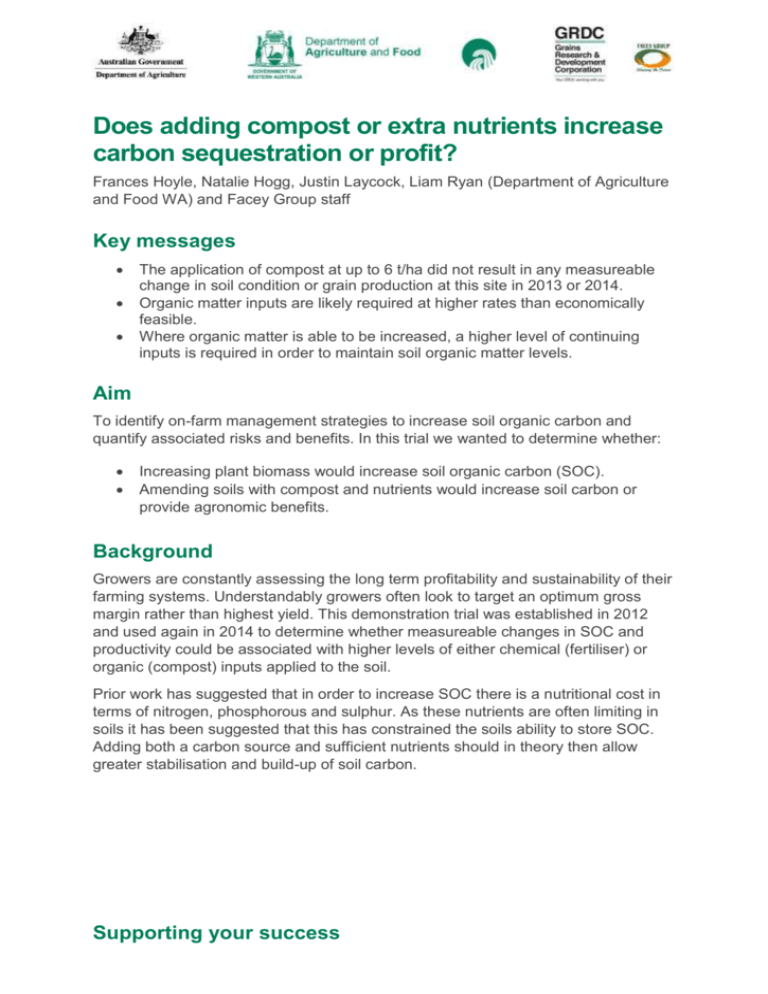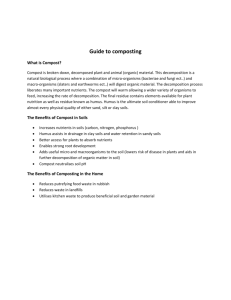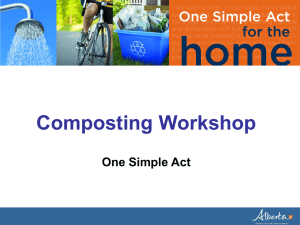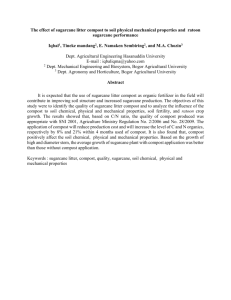Trial details - Department of Agriculture and Food
advertisement

Does adding compost or extra nutrients increase carbon sequestration or profit? Frances Hoyle, Natalie Hogg, Justin Laycock, Liam Ryan (Department of Agriculture and Food WA) and Facey Group staff Key messages The application of compost at up to 6 t/ha did not result in any measureable change in soil condition or grain production at this site in 2013 or 2014. Organic matter inputs are likely required at higher rates than economically feasible. Where organic matter is able to be increased, a higher level of continuing inputs is required in order to maintain soil organic matter levels. Aim To identify on-farm management strategies to increase soil organic carbon and quantify associated risks and benefits. In this trial we wanted to determine whether: Increasing plant biomass would increase soil organic carbon (SOC). Amending soils with compost and nutrients would increase soil carbon or provide agronomic benefits. Background Growers are constantly assessing the long term profitability and sustainability of their farming systems. Understandably growers often look to target an optimum gross margin rather than highest yield. This demonstration trial was established in 2012 and used again in 2014 to determine whether measureable changes in SOC and productivity could be associated with higher levels of either chemical (fertiliser) or organic (compost) inputs applied to the soil. Prior work has suggested that in order to increase SOC there is a nutritional cost in terms of nitrogen, phosphorous and sulphur. As these nutrients are often limiting in soils it has been suggested that this has constrained the soils ability to store SOC. Adding both a carbon source and sufficient nutrients should in theory then allow greater stabilisation and build-up of soil carbon. Supporting your success Trial details Property Plot size and replications Soil type Paddock rotation Treatment: Fertiliser Treatment: Compost Hinkley, Tincurrin 2013: 140m x 10m (control replicated x 4 strips) 2014: 10m x 30m; 3 replicates Grey deep sandy duplex (gravel below 25 cm); Grey Chromosol (4% clay in 0-20 cm, increasing to 8% 20-30 cm) 2013: Volunteer pasture 2012: Wheat 2011: Volunteer pasture – sub-clover base 2010: Wheat 2009: Pasture 2014: 0, 100, 170 kg/ha Agras Extra 2012: nil, 1, 2, 3 t/ha 2014: nil or 3 t/ha Activity 2013 Crop type Volunteer pasture Sowing date Seeding rate Growing season rainfall Nil Nil 296 mm Nil Herbicide Fertiliser 100kg/ha Super & Potash 2:1 2014 Wheat (cv. Yitpi) cut for hay due to weeds 16 May 45 kg/ha 325 mm 0.3 kg/ha Diuron 1 L/ha Glyphosate 0.003 kg/ha Metsulfuron 0.15 L/ha Chlorpyrifos 0.075 L/ha Alpha-cypermethrin 0.35 L/ha LV Ester 680 as per treatments Results 2013 Soil Baseline testing at the trial site indicates pH levels are below target levels in both the topsoil (target pH 5.5) and subsoil (target pH 4.8). With aluminium becoming soluble at a pH of 4.5 in calcium chloride this data suggests that lime is required at this site and that soil pH may constitute a constraint to plant growth. There were no measureable differences observed in soil condition for any of the compost treatments previously applied at this site in 2012 including soil organic carbon or nutrients (Table 1). Potassium concentrations are low at this site (Table 1). Table 1 Soil condition in March 2013 under prior compost treatments of 0, 1, 2 and 3 t/ha. Data is the average of three depths (0-10, 10-20, 20-30cm). P Ammonium (mg/kg) Nitrate (mg/kg) Nil 5 14 18 38 7 0.05 4.6 0.7 1 t/ha 5 14 21 37 9 0.05 4.9 0.7 2 t/ha 7 11 20 33 9 0.05 4.8 0.7 3 t/ha 5 12 15 41 9 0.04 4.5 0.7 Treatment K S (mg/kg) (mg/kg) (mg/kg) EC pH SOC (dS/m) (CaCl2) (%) While no measureable differences (p<0.05) were observed in soil organic carbon (SOC) for any of the compost treatments applied at this site in 2012, both the concentration of SOC (%) and the calculated SOC stocks decreased with increasing depth (P<0.001) as would be expected (Table 2). The amount of carbon contained in the upper 30 cm of soil (bulk density adjusted) at this site was 28.4 t C ha in the nil plots and 27.3 t C ha in the compost plots, with no measureable difference with increasing rates of compost. The microbial biomass (mass of microorganisms) at this site in surface soil (0-10 cm) measured 75 kg/ha or 66 mg C/kg soil, which is low. Water holding capacity (0-10 cm) of this soil is approximately 26%. Water repellence was variable across the site and was either not observed, or was low at this site. Table 2 Soil organic carbon and nitrogen (%; Elementar) sampled in March 2013 under prior compost treatments of 0, 1, 2 and 3 t/ha at three depths (0-10, 10-20 and 20-30cm). Compost Treatment Nil 1 t/ha 2 t/ha 3 t/ha Nil 1 t/ha 2 t/ha 3 t/ha Nil 1 t/ha 2 t/ha 3 t/ha Depth (cm) 0-10 0-10 0-10 0-10 10-20 10-20 10-20 10-20 20-30 20-30 20-30 20-30 SOC (%) 1.45 1.42 1.30 1.15 0.54 0.66 0.54 0.49 0.39 0.34 0.35 0.39 SON (%) 0.122 0.12 0.12 0.10 0.05 0.07 0.05 0.06 0.05 0.04 0.03 0.04 C_N ratio 12 12 11 12 10 10 11 9 9 10 10 9 SOC stocks (t C/ha) 16 16 14 13 7 10 8 8 5 5 4 5 Plant measures The site was under volunteer pasture in 2013 and was sown to wheat in 2014 to establish any production outcomes associated with the application of compost and different rates of fertiliser. 2014 Compost analysis Compost used in this trial had an organic carbon content of 3.6%, cation exchange capacity (CEC) of 32meq/100g and a pH (in CaCl2) of 7.2. While the carbon to nutrient content was relatively high (C/N ratio of 9:1), the rate of application suggests there would be a limited influence on nutrient availability with the equivalent of <1kg/ha nitrogen, <2kg/ha phosphorous, approximately 9kg/ha potassium and <1kg/ha sulphur per tonne of compost applied. Soil - March Soil samples (10 cores per plot, 0-10cm) taken immediately post application of the compost at 3 t/ha indicate no measureable change in SOC (average 1.5%) or bulk density at this site for any of the treated plots. Therefore no calculated change in SOC stocks was determined. This suggests the rate of application to be insufficient to cause a measureable change in soil carbon stocks. This could be expected given a baseline carbon stock of 28 t/ha and a minimum likely error of at least 10%. Soil - December Soil parameters measured after harvest in 2014 again suggested no differences in soil condition that have resulted from the application of compost or fertiliser (Table 3 and Table 4). Table 3 Soil condition for treatments sampled in December 2014 under different compost (0, 4, 5, 6 t/ha) treatments. Data is the average of three depths (0-10, 1020, 20-30cm). Measure SOC% SON% C/N ratio Ammonium Nitrate Phosphorous Potassium Sulphur Soil pHCaCl₂ Microbial biomass (mg/kg) Total Total Total Total applied applied applied applied Compost Compost Compost Compost 0 t/ha 4 t/ha 5 t/ha 6 t/ha 1.1 1.0 1.0 1.2 0.09 0.08 0.08 0.09 12 12 13 13 4.0 2.8 4.5 3.3 s.e. ns ns ns 0.4 7 20 54 6 4.9 7 19 57 5 4.8 7 21 50 5 4.9 9 24 42 4 5.0 ns ns ns ns ns 138 98 131 215 ns Table 4 Soil condition for treatments sampled in December 2014 under different fertiliser (0, 100, 170 kg/ha Agras Extra) treatments. Data is the average of three depths (0-10, 10-20, 20-30cm). Measure SOC% SON% C/N ratio Ammonium Nitrate Phosphorous Potassium Sulphur Soil pHCaCl₂ Microbial biomass (mg/kg) 0 kg/ha Fertiliser 1.0 0.08 12 4 100 kg/ha Fertiliser 1.1 0.08 12 4 170 kg/ha Fertiliser 1.1 0.09 12 4 s.e. 7 20 51 4 4.9 8 22 50 6 4.8 7 20 57 7 4.9 ns 1 ns ns ns 137 133 153 ns ns ns ns ns Plant measures Plant count at 1-2 leaf stage (plants/m2) Plant establishment for the wheat crop sown on 16th May and conducted 5th June 2014 at growth stage Z11 (first leaf) showed a 30% better plant establishment in the nil fertiliser treatments (105 plants/m2) as compared to treatments where fertiliser was applied with the seed at 100 or 170kg/ha (69 and 76 plants/m 2 respectively). Compost had no influence on plant establishment in this trial. 120 100 80 60 40 20 0 0kg/ha fertiliser 100kg/ha fertiliser 170kg/ha fertiliser Plant count at 1-2 leaf stage (plants/m2) Figure 1 Plants establishment (plants/m2) estimated at 1-2 leaf stage in wheat (2014) for fertiliser treatments (data is the average of all compost treatments) and bar represents the standard error of the mean (p<0.05). 100 80 60 40 20 0 0t/ha 4t/ha 5t/ha 6t/ha compost compost compost compost Figure 2 Plants establishment (plants/m2) estimated at 1-2 leaf stage in wheat (2014) for compost treatments (data is the average of all fertiliser treatments) and error and bar represents the standard error of the mean (p<0.05). The differences in plant establishment did not translate into yield with the high fertiliser treatment yielding 15% more than the nil treatments (Table 5). The efficiency of nitrogen use was on average 16 kg N/t grain produced. Table 5 Plant responses to increasing fertiliser rate (average of total compost applied at 0, 4, 5, 6 t/ha) Fertiliser (kg/ha) 0 100 170 LSD (p<0.05) Grain yield (t/ha) 3.09 3.32 3.54 Grain protein N uptake (11% moisture) (kg N/ha) 9.3 48 9.6 53 9.9 58 0.35 0.3 HLW (kg/hl) 77.4 77.1 76.8 Screenings (%) 4.5 4.0 3.7 ns ns 5 Higher fertiliser rates (170 kg/ha Agras) increased grain yield by 0.5 t/ha from the control that had nil fertiliser. It did not result in any significant gains in yield or quality when compared to a lower rate of fertiliser application (100 kg/ha Agras, Table 5). Based on the rotational history, amount of N applied as fertiliser (16, 27 kg N/ha) and the N uptake in treatments receiving no fertiliser, we can conclude that the majority of N was soil derived and resulted primarily from soil organic matter turnover. From the results above we could calculate the fertiliser use efficiency to be approximately 34%. Compost had no effect on grain yield. Grain yield averaged across all compost treatments was 3.32 t/ha which was no different to the nil compost treatment (averaged across fertiliser treatments). As compost rates increased there was a tendency to have lower grain protein which results in lower N uptake – but this was not significant at the 5% level. Economic analysis While no extensive analysis has been done on the economics of these applied treatments, the application of compost did not result in any measureable agronomic benefit and thus to date has been an expense with no associated return. This would suggest that at the rates applied there was no economic benefit from applying compost at this site. The profit from fertiliser application suggested a marginal return on investment (Table 6). Table 6 Returns to fertiliser treatments imposed in 2014 on a grey deep sandy duplex near Wickepin Fertiliser rate (Agras Exra, kg/ha) Fertiliser Expense Yield (t/ha) Grain Income/ha Current balance/ha 0 $0 3.09 $927 $927 100 $65 3.32 $996 $931 170 $110.5 3.54 $1062 $951.5 *Price Notes: Current balance is based on price paid for fertiliser and price received for wheat. Assuming $650/tonne paid for Agras Extra in 2014 and that wheat was received as APW2 and received $300/tonne in 2014. All other inputs and management were the same for each treatment so not included in the calculation. Comments The application of up to 6t/ha of compost over the past 3 years has not resulted in any measurable change to soil organic carbon or other agronomic benefits at this trial site. This is likely due to the relatively low rate of application against a much larger background carbon status. Increasing fertiliser rates from 0 to 170 kg/ha increased grain yields and N uptake with no loss of grain quality. Acknowledgements Thanks to the Facey group and their growers for continued interest and support for this project, sampling help and management of the trial site. A special thanks to the Hinkley family for access to the trial site and assistance for the duration of the trial. Also thanks to Richard Bowles (UWA) for analyses. This project is led by the Department of Agriculture & Food WA in collaboration with the Facey Group and is supported by funding from the Australian Government Department of Agriculture - Action on the Ground program and the GRDC. Contact: Frances Hoyle frances.hoyle@agric.wa.gov.au Abbreviation Meaning kg/ha t/ha L/ha kg/hl mg/kg mm C/ha N/ha LSD s.e. CEC N C P K S OC CaCl2 LV HLW APW2 C/N ratio Kilogram per hectare Tonne per hectare Litre per hectare Kilogram per hectolitre Milligram per kilogram Millimetre Carbon per hectare Nitrogen per hectare Least significant difference Standard error of the difference Cation exchange capacity Nitrogen Carbon Phosphorus Potassium Sulphur Organic carbon Calcium chloride low volatility Hectolitre weight Australian premium white 2 Carbon nitrogen ratio






